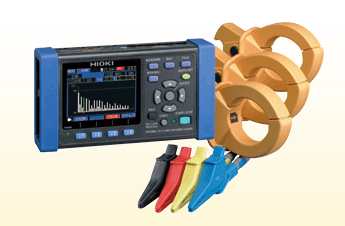Latest Test and Measurement News
 3-Phase 4-Wire Energy Logger with Harmonic Analysis Capabilities
3-Phase 4-Wire Energy Logger with Harmonic Analysis Capabilities
28 June 2013 - Hioki E.E. Corporation launches the Clamp On Power Logger PW3360-21 for advanced energy logging and power efficiency analysis. The new power logger adds harmonic measurement functionality to the PW3360-20, which was launched in December 2012.
Today power inverters are being broadly applied as the energy-saving performance of electrical devices continues to improve and solar power systems become increasingly popular. Yet while inverters are contributing to both of these trends, they also emit harmonics that can interfere with the proper operation of electrical devices and the electronic components they use. Demand for harmonic analysis capability is growing due to the need to limit its adverse impacts.
The PW3360-21 can measure harmonics found on voltage and current signals, and can display a variety of measurement parameters, including harmonic RMS values, content percentages, and phase angles, in both list and graph form. It can also save measured values on an SD memory card at a user-specified interval. Moreover, the optional Power Logger Viewer SF1001 PC application can be used to display time-series graphs of harmonic data on a computer, further aiding in harmonic analysis.
“The PW3360-21 takes the PW3360-20 one step further by enabling customers to capture critical harmonic data while managing their power, providing even higher work efficiency and analysis capabilities,” comments Hioki lead engineer Sadanori Miyajima.
Harmonics and Their Effects
Many electrical devices and equipment sold today utilize power inverters, which are used to improve energy-saving performance due to their ability to control the frequency, voltage, and current of AC power supplies. Power inverters are often seen in both industrial and consumer products such as air conditioners and electric vehicles to lower power consumption and improve fuel economy. Inverters also are used in solar power systems, where they are needed in order to convert the DC power generated by solar panels into the AC power used by household appliances.
Power inverters improve energy-saving performance and aid in the use of natural energy sources, but they also emit harmonics, which are defined as electricity waveforms with frequencies that are integer multiples of standard power supply frequencies. These harmonics have adverse effects on electrical equipment and devices as well as the electronic components they use. For example, they can cause video images displayed by household electronics to exhibit flickering and noise; computers to malfunction; and capacitors and fuses in devices to overheat or burn up. Depending on the extent of such heating, the risk of fire may also increase.
www.hioki.com/


